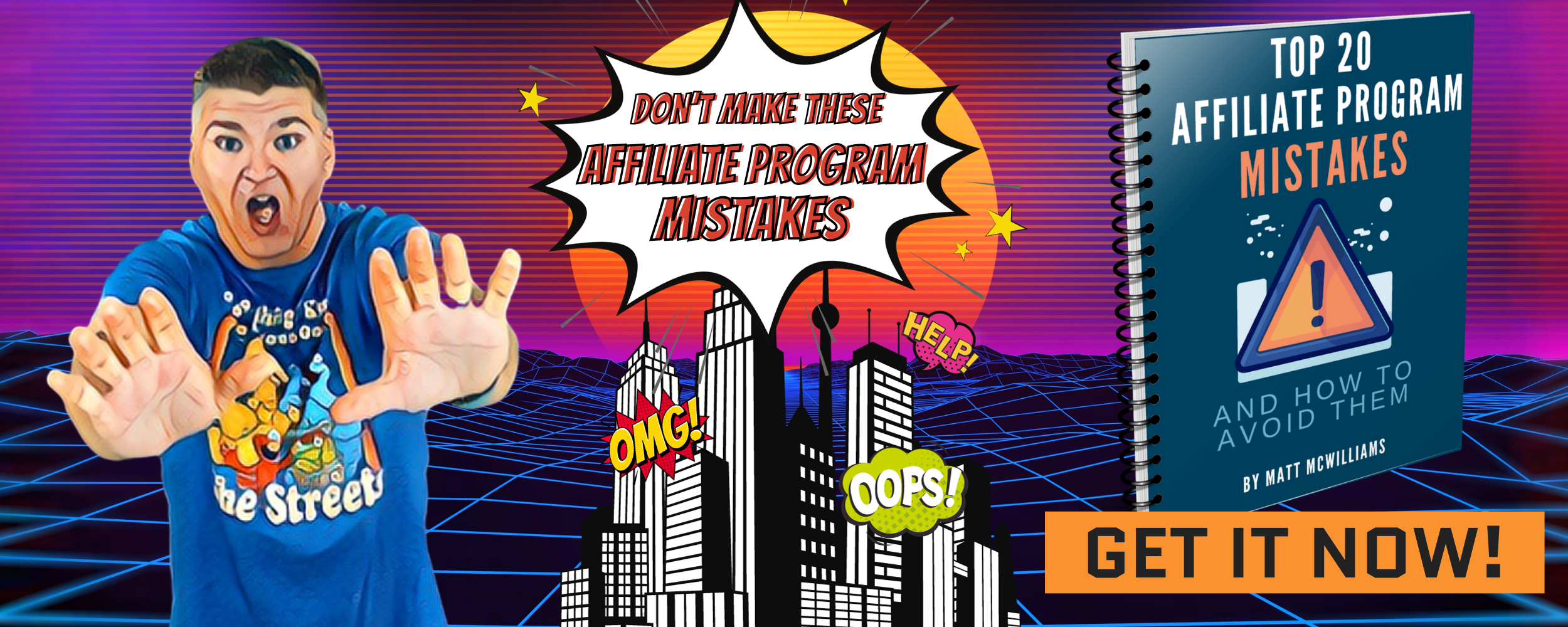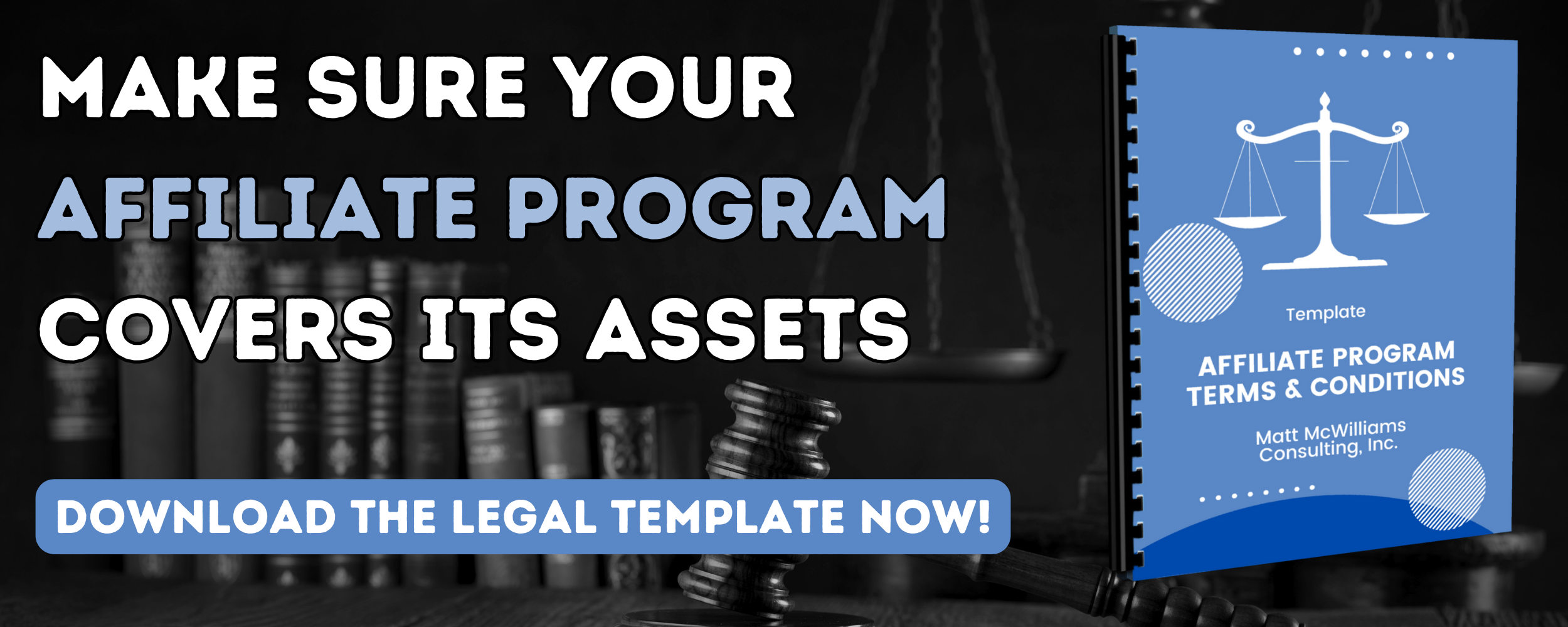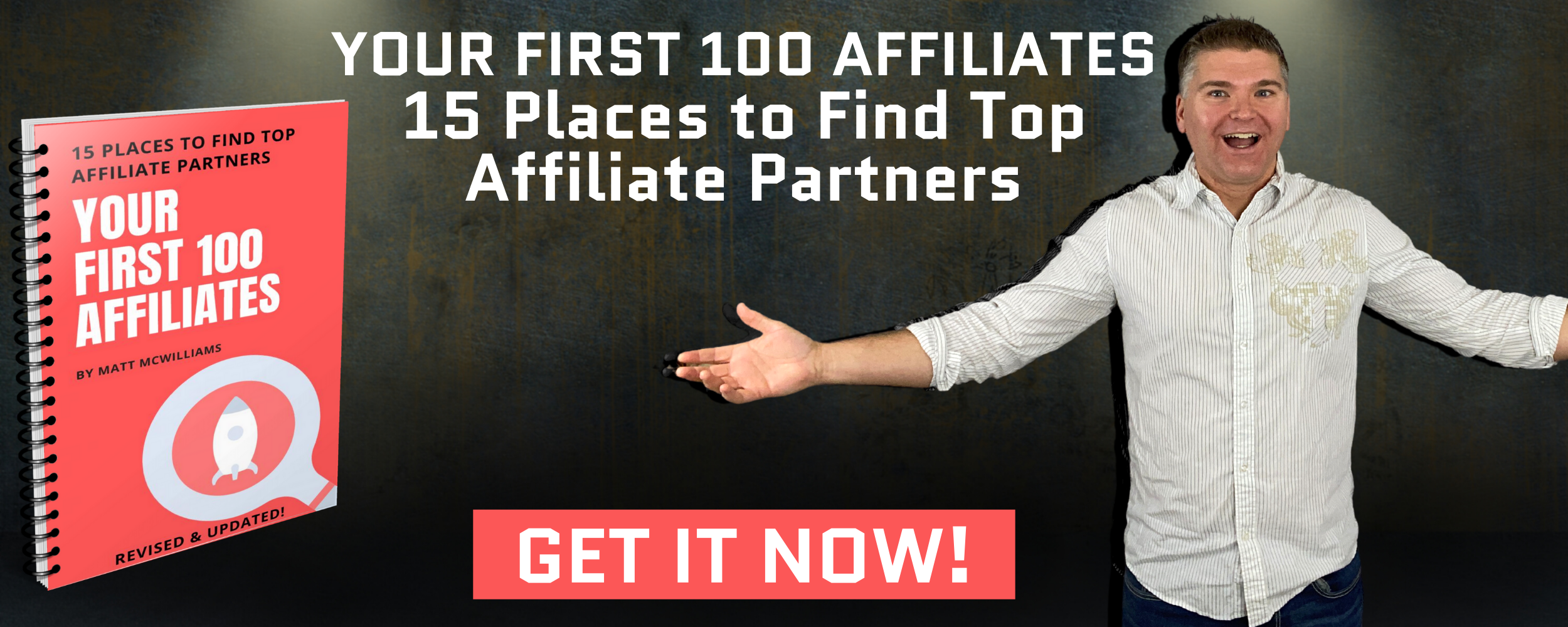Let’s be honest: managing a successful affiliate program isn’t a walk in the park. Every affiliate program faces its share of challenges that can hinder its success. In this episode, we’re tackling the 15 biggest challenges that affiliate programs encounter and exploring why they can be so problematic. But there’s good news…this isn’t just about the hurdles. I’ll also guide you through effective strategies to overcome these obstacles and propel your program to new heights.
Click Here for The Written Transcript of This Episode
Need help activating your affiliates? Use my proven email templates for getting inactive affiliates in the game and making sales! Get them here!
Links Mentioned in this Episode
VIDEO – How to Decide the Right Affiliate Commission Structure
Your First 100 Affiliates Report
Affiliate Activation Email Templates
Text me at 260-217-4619
Don’t Miss An Episode – Subscribe Below
Previous Episodes of The Affiliate Guy
What the Latest Research Says About Affiliate Bonus Packages
How to Give Your Affiliates What They Need to Succeed
How to Build an Army of Loyal Affiliates
Got a Low-Priced Product? Here’s How to Run an Affiliate Program
How Top Affiliates are Closing Sales in 2024
How to Find Affiliates Using Affiliate Program Leaderboards
How to Solve the 15 Biggest Challenges for All Affiliate Programs
I wish I could lie to you and tell you that running a successful affiliate program is easy, but it’s not. In fact, there are a lot of challenges that get in the way of doing so. And today I share 15 of the biggest affiliate program challenges and why they often hold people back. But don’t worry, this episode isn’t all doom and gloom.
I’m also going to share how to solve those challenges. So we’re talking about challenges today, not challenges like we talked about a few episodes ago, running a challenge. We’re talking about the obstacles, the things that get in the way of a successful affiliate program.
And I have 15 of them, as I mentioned. Now, why 15 actually has nothing to do with that’s a good number or anything like that. Actually, the reality is the studies show if I wanted to make this the
perfect title, there would have been 17 and I would have done what I teach, which is get it to 17 or I would have cut it back to ten. But when I thought about what have been the biggest obstacles, and I’ve been in this for 18 years, we kind of front, if I did, did this last year, 17 and 17, oh, you know, that would have been a good thing. But like, when I made the list, there were 15.
That’s what we ended up with. You know, there were 15. There wasn’t a 16th and there wasn’t one where I was like, I could kind of cut that out.
And so I want to start at the very beginning. As we go through this, we’re going to kind of go in phases as it worked out. And I think there’s roughly five. I run through the list here.
There’s roughly five in each phase. We’re going to start at the very, very beginning. Before you even bring on affiliates, what are the challenges that even get you to that point? And the first challenge is finding the right technology, the right technology that has the right kind of tracking.
You know, that’s number one. If it doesn’t track, if affiliate sales don’t track, if it doesn’t track from the contact record, from the click through the contact record, you know, 97, 98% of affiliate sales are being attributed correctly. Well, then that’s a big problem.
So we got to find the right tracking. There’s tons of stuff out there. I’ll share ultimately what my recommendation is here in a moment.
But you also need good reporting. What do you need in terms of reporting? You need daily numbers. You need to be able to run a report that says, show me what’s happening for this time period.
You need your conversion stats. You need to be able to see, you know, at least see or create leaderboards. You need to know who your inactives are.
Even if it’s a little hard to get and requires a little digging, it must be accessible. Those are the big things you need to know. You need to know who’s moving, who’s growing, who’s growing month over month, who’s going stagnant, who’s falling off, who was doing $2,000 a month on average in 2022, and now they’re
doing $1,000 a month in 2023. So we can reach out to them. Reporting is not just about having cool stats or being able to put together really cool pie charts or graphs. It’s about the actions that you take as a result of that reporting.
So my recommendation is go with whatever you have if it’s an integrated solution, you know, number one thing you said is tracking. So you need cookies, you need contact record, and then look at reporting. I can’t make a recommendation for any individual or for a blanket statement until I know their individual needs and I know their
individual situation. If you’ve got a shopping cart set up on Shopify, I’m going to have a few different recommendations. If you have a retail product, I’m going to have different
recommendations. If you’ve got lead magnets into sales, into a webinar, into a video series, I’m going to have different recommendations. Odds are your current integrated solution, that is, if you’re on
clickfunnels, if your opt in pages, your webinar pages, and your sales pages and your order forms are on clickfunnels, clickfunnels is the best affiliate tracking for you. Do I love it? No, I don’t.
Do I have major issues with it? Yes, I do. But that’s the best one. If that’s what you’re using.
Don’t make the same mistakes I’ve made with my affiliate programs. Learn my top 20 affiliate program mistakes…and how to avoid them!
If you’re on Infusionsoft and all that stuff through Infusionsoft, then Infusionsoft is your best option. So it just really depends. There’s so many recommendations.
So that’s the number one challenge is finding the right technology. And if you’re like, I really don’t know, man, like, here’s my situation.
What should I set up? Text me at 260-217-4619 I’ll make the best recommendation I can based on your situation. The second thing, the second big challenge is website problems. If you’ve got problems with loading speed and image and video
quality, like how to navigate your website, is it easy, the responsiveness, does it work on mobile? I mean, we found an issue on my website the other day, pretty important page, and when I switched to an iPhone 14 and I’m like, oh my gosh, this button goes off the side of the page. Not a huge deal, but it cuts off like the last two letters of the text.
That was not the case on iPhone twelve. So as far as I know, it wasn’t the case on the iPhone 13. I don’t know. We didn’t test it on that.
It was not the case on the eleven. It was not the case in all the mobile testing that we did. But for whatever reason, when I switched phones, this thing was cutting off and so we had to address that. That’s a problem.
We figured it out. It was super easy. Well, is that an issue? You need to address those things before you have affiliates, your content quality, your sales page, your payment options.
Do you have the right payment options if the majority of your audience uses PayPal, especially with lower ticket items, for instance, we don’t offer PayPal in our high ticket stuff. Nobody ever used it. We had it for years.
Not one person ever used it. But on our low ticket stuff, like $17 to $500, tons of people use PayPal. So make sure you have the right payment options. Traffic leaks if you have a giant phone number on the top of your page that doesn’t provide any tracking and somebody calls in.
If you’re not using the right tracking, that tracks contact record and stuff like that, the affiliate’s not going to get credit. If you’ve got a ton of external links that are easy to get to. If you’ve got links to other products, your own affiliate links. If you’ve got links to pages on your site that aren’t going to track, that’s a problem.
You can’t have that. If you get an affiliate program, sometimes that means you need a separate funnel for your affiliates. You need separate landing pages, usually pretty easy.
You can clone and edit, and it doesn’t take hours and hours. Usually you can. I mean, like we can clone an entire sales page and with tons of stuff, we can clone it in 20 minutes for our affiliate, maybe ten. So the solution here, if you’ve got website issues, fix them, compress your images, get a better server, really like you’re hosting on a $30
a month server. If you upgrade to like, we recommend Agathon. That’s who we use. If you want mattmcwames.
com forward slash agathon. Right? It’s like a hundred. I don’t know.
We pay like a month. We’ve got a few other things that we pay for, but the hosting itself is like a month, $70. If I make one additional sale of a $500 product and pay the $200 commission, I’m $230 in the black on that one. So get a better server.
Test on all browsers, test on mobile. Right? Hire a copywriter, add payment options. We just added PayPal again to a few things that we’d missed over the years.
Close those leaks. That’s how you fix your website. The third thing is conversion issues. Now, this sort of ties in what we talked about, but this isn’t like
errors. Sometimes, even though your website looks great, it works great. The button doesn’t just go off randomly off the side of the screen on an iPhone 14, it fails to convert visitors into buyers. Maybe certain payment options don’t work.
We found out years ago we had a page, and for some reason, unbeknownst to anybody, we never figured out why. We just ended up deleting the page and recreating it from scratch.
International orders would not go through. Crazy. So what are the reasons why your website’s not converting? How do we optimize the sales page?
How do we optimize the landing page, the follow up? Like, how do you optimize your follow up so that if somebody sends 100 visitors, an affiliate sends 100 visitors? Yeah, you might sell one person through your own efforts, and they might sell one person through theirs. But how do you convert an extra person?
How do you get that conversion up to one additional person out of How do you optimize your shopping cart, your sales page, things like that? These low conversion rates are going to prevent affiliates from ever signing up. So again, we just talked about increasing speed.
But check your pricing, make sure it’s competitive. More payment options. And I don’t just mean PayPal, things like that. What about financing or payment plans?
More support options, chat and email. Money back guarantee the longer is better. Longer money back guarantees are better. And here’s why.
The longer the money back guarantee, the lower the return rate. Because when somebody sees a one week return or a two week return, there’s a ticking time clock.
And if they don’t get to it in two weeks, they just return it. But if it’s 90 days, six months, I also say this, quite frankly, they forget about it. But they also gives them time to actually implement. If it’s a course, for example, they have time to go through it and
they’re not going, okay, I got to finish this course in two weeks. And then life got in the way and somebody got sick and I had other things to do. I got busy with work and nevermind, I’ll just return it.
And make sure that you have exit intent pop ups on your landing pages. You can capture an additional five to 10% leads on those. On your sales pages, make sure you have x and intent and pop ups and offer some sort of a discount, or at least capture the lead. We did this with my book.
I talked about this a few episodes ago where thousands of people bought the book, but we also had like 1000 people opt in. I don’t think it was quite a thousand, but we had like eight or And we converted 20% of those into buyers.
So you think about that. You go, let’s just go with 800. That means we converted 160. That’s 160 people who otherwise we would have never converted.
That’s not a huge deal. But out of a couple thousand, I mean, that’s, you know, we’re increasing our close rate by six, 7%. That’s actually a pretty big deal. Make sure you’re retargeting.
Just don’t use an affiliate link to retarget track in other ways, like using a UTM, Universal, whatever UTM stands for universal tracking. I forget what it stands for. So look that up in a minute, but make sure you’re retargeting. These are usually super cheap.
You retarget like cart abandons. Usually you can pay $5. I mean, we’ve done it where we’ve done like thousand dollar sales for five to $10.
Why should I have to pay that? That’s, you know, I gotta pay the affiliate commission too. Yeah, you’re gonna pay dollar 400 for the affiliate commission and an extra $10 for the sale.
I mean, do you like, that’s. Sometimes I hear, hear this from people and I’m like, really? Do you hear what you’re saying? You’re going to pay $10 to make 600.
Even take out the credit card processing. So the credit card processing, 30 on 1000. So you’re going to pay $10 to make 570. I mean, sign me up for a machine where I can put $10 in and it cranks out 570.
In fact, sign me up for a machine where I can put $10 in and get 20 all day long. I’ll just sit there all day long putting $10 bills into the machine. So make sure you’re retargeting. Make sure you’re testing different parts of the funnel.
Raise prices lower, prices change. Copy things like that. Offer bundles. This can significantly increase your AOS, which is your average order size.
Just do the math. A 10% conversion with a dollar 50 a OS, that’s $5 right there. That’s better than a 15% conversion with a dollar 30 OS, which would be 450. So, yes, your conversions could be an issue, but your AOS matters, too.
Again, if I’ve got an affiliate program and my conversions are is enough higher to make up the difference. Well, the affiliate’s gonna make more money promoting you than me. So, speaking of money and making more money, next challenge is determining the right commission or another way. I kinda went back and forth on this one.
Uncompetitive commissions. Now, I’ve got a video that I’m going to link to in the show notes on how to decide your commission structure. And that’s linked in the show notes. It goes through in detail.
It’s about a 1012 minutes video that goes through in detail. But the gist is this. Number one, you start with your price. So let’s just say dollar 500.
Then you subtract your incremental costs. What’s incremental means it’s an incremental per unit cost. It’s not. Oh, it cost me $1,000 to record the course.
You’re going to pay that $1,000 whether you sell one or a thousand. So let’s just say I got to pay $100 per unit. So the most you can pay in breakeven is $400. In other words, if you paid your affiliates an 80% commission on Then you want to subtract your time.
Now, this is incremental. So this is not why I have to record the course again or I have to make the product. No, for most of you, this is nothing.
You don’t have time. But let’s say you offer a ten minute call with every customer, and you value that at $100. Well, now you’re down to 300.
And then lastly, you want to take a look at the market. You got to be in the same ballpark. If the market’s at 30%, you have to be at 25%. If the market pays a flat fee of $100 per sale and you offer 20% of
a $200 sale, you’re going to get your buck kicked. They offer $100, and you offer 40% of a $100 sale, you might still get your buck kicked. So think of creative ways where you can be competitive.
You’ve got to be competitive and go check out that video, because it walks you through in detail. And the fifth challenge is clearly defining the program policies. This is the boring legal stuff. All right, this is boring, but it’s important.
So things like, you’ve got to get clear on your cookie duration, I recommend lifetime. I’ve done numerous episodes on that, but be clear on the exact length and be ready to explain the why if you don’t offer a lifetime commission, why?
Why don’t you your affiliate eligibility criteria like I’m not a big fan of restricting who can sign up, but there sometimes are reasons why you can’t accept affiliates from a certain country. There are sometimes reasons why you can’t accept affiliates from a certain state.
So you need to define the eligibility criteria that affiliates must meet to join the program. Do they need to have a certain number of website followers or something?
Website visitors or something like that? Your intellectual property, your ip. You have to define your IP policies. Like are they allowed to use trademarks?
Make sure that your affiliate program has a solid agreement (AKA Terms & Conditions). To make things simple, grab my template here!
Are they allowed to use copyrighted material? Like they should not use your company trademark or any copyrighted material unless they have permission. So if you provide content and it’s copyrighted, just make it clear that they’re allowed to use it. Affiliates are allowed to use it.
No one else is. But they are. What are your PPC, your pay per click bidding rules? Are they allowed to bid on your trademark name?
There are certain keywords they can’t bid on. I recommend at the very least, you don’t allow them to bid on something like let’s say the name of your company is Acme Corp or Acme widgets. They’re not allowed to bid on Acme widgets.
Sucks. So sucks has to be a negative keyword or scam has to be a negative keyword. Negative words need to be negative keywords.
Negative keyword means that they can still bid on if we allow it. If we allow them to bid on Acme widgets, but then the person types in Acme widgets suck, then they would show up and we don’t want that. So those are the types of things where you have to be very clear in your PPC bidding rules.
Same thing with your promotional rules and restrictions. We’re going to talk about more about those later. Is there any prohibited content? You know what affiliates cannot promote like this kind of goes back
to types of websites that we would allow. There are times where we don’t allow a website because of the content, if it’s illegal, if it’s offensive, if they’re doing things that we just don’t agree with from a moral or ethical standpoint, our client doesn’t want to be associated with them, then we’re not going to allow them to promote.
It. Doesn’t matter what state or country they’re in. Doesn’t matter how, they could have a million website visitors a day. We’re not going to allow them in.
You want to get clear on how our commissions determine. First click, last click. Is there a split? We’ve talked about that before.
Your payout terms, the frequency and when. And then lastly, get clear on why you would kick somebody out, the circumstances in which you would terminate an affiliates agreement. So violations of company policies, fraud, do you kick them out for non performance? I don’t recommend that.
But do you then just get clear on it. So those are the early, kind of like the pre, even affiliate launch before you even bring on an affiliate challenges. Next we’re going to talk about the early stages of building your affiliate program. What are the challenges you face in the very early stages of building your affiliate program?
So the six biggest challenge, and it’s the first one here kind of in this early stages, you’ve actually, you’ve built the program, you’ve got the right commission, you’ve addressed those conversion issues, you got the right technology, you’ve fixed any website problems, you’ve clearly defined your policies. Now we’re going right.
What are the problems we face now that we’ve built the actual program and it’s ready to go from a legal standpoint? Well, the first biggest problem there, the 6th overall, is finding the right affiliates. I talk so much about this, I’m not going to discuss this, but I wanted to make sure that I at least highlighted this as, okay, it is a challenge.
So I’ve got two solutions for you. Number one, the training that I mentioned earlier. We’ve got the training coming up how I built a million dollar a month affiliate program in only two years without any connections or credentials.
So this applies like, okay, you can have a program that’s just starting out and you don’t have to have connections. If you’ve got 30 friends who all have big lists and they can promote you, you don’t need any of what I’m talking about. Now you can go do a $20 million launch, no problem. Oh, I’ve already got 200,000 people on my list.
You can go do a big launch. You don’t need any of that. But if that’s not you, which is 99. 9%
of the world, come to the training. So we’ll link to that in the show notes. It’s mattmclaims. com
million a month. We will link to that in the show notes. The second thing is go grab my free report about how to find your Mattmcwilliams. com first 100 first 10 zero and it will walk you through.
We’ve even got some email templates in there that you can use. This is a big challenge, finding the right affiliates, finding any affiliates, not so hard. Finding the right affiliates. Pretty big challenge.
Which then leads to the next challenge. This is what the last episode was all about. I talked about how to turn in active affiliates into your best partners. The 7th challenge is affiliate activation.
So if you haven’t listened to that episode, go back and listen to it. I walk you through and in that I talk about our affiliate activation email templates which you can grab@mammothwilliams. com
activate that will address that. All right, so finding the right affiliates and activating them now, we’ll go into depth on some of these here. Number eight is affiliate retention. How do we keep affiliates?
The reality is we work so hard to recruit them, and then we activate them. How do we keep them? How do we keep them? In the last episode, I sort of touched on a little bit because I talked about, in the activation side, I talked about, what are some of
the reasons why affiliates aren’t active? Maybe because of a competitor or because of they’re not getting what they need. We’ll talk about that in a little bit here.
They’re not getting the resources they need. That’s the same reason why they leave sometimes, as I talked about in the last episode, you’ve got an inactive affiliate. They signed up, and they never become active.
Here we are three months later, they still haven’t done anything. That’s like your inactive inactives, right? They’ve never been active, and they’re still not active. Then you’ve got just your regular inactives, which are maybe they
were active 90 days ago, and then they haven’t done anything. So how do we keep them active? How do we just keep them, period? Well, the next two challenges are going to cover a lot of that, but I’m
going to give you the big one, relationships. Relationship building, developing and nurturing and growing, and just really making it a priority to build and nurture those relationships with your affiliates. That’s how you keep them.
I remember years ago when I worked in the insurance industry, we sold insurance leads to agents. This is back in, this is like 2007, 2008. We had about 15 of our top agents come into Nashville, and we wind and dined them, and we brought them in because we were
redesigning our system, and we wanted to know what they wanted. So it was like a mastermind. They were sharing ideas, what works. We kind of divided the day up so we would know how they’re operating, and they could mastermind for an hour or so.
And then we wanted to quiz them, like, what do you need? How do you want this system to work? What are all the features? You want the bells and whistles?
All that. Then we go have fun with them at night. And I remember on the second day, we’re sitting with this good old boy from Texas. Literally, you know, wore a cowboy hat.
And I forget what that thing’s called, but the little, it’s like the necktie with the strings hanging down. It’s got like the gym at the top. And that word’s gonna come to me at the, like, the most random time.
Later today, I’m gonna be like, talking to somebody, I’m gonna shout out what it is. And so anyway, he’s sitting there and he’s like, you know, this guy has raved about us for two days. He’s referred probably six or seven clients to us. This guy loves us.
He is a raving fan, and he’s talked nothing but good for the last 12 hours. Been the life of the party all. And he goes, you know, now that I come to think of it, y’all’s leads ain’t been working out too well the last here few months.
And I’m like, we’re kind of like, what? You’ve been raving about us, referring people to us? And he’s like, yeah. He’s like, now that I look at the numbers, I ain’t been closing no leads.
He’s like, the quality just has been going down. And we’re like, well, that’s not good. And he’s like saying in front of all these other top agents, but why was he still with us? He’d been with us for two years.
He’s still referring people to us. He’s raved about us for 12 hours. And yet over the last couple of months, things have slipped. Why is he still with us?
Why is he raving about us? Why all those things? Because we had a great relationship with him. We’d nurtured that relationship.
And that’s the power of relationship. Even if somebody comes along and offers a little bit better commission, offers a little bit better of something, if you’ve got a great relationship, you’re going to win. All things being equal, Jeffrey Gittimer says one of my favorite
quotes of all time, all things being equal, people want to do business with their friends. All things not being equal, people still want to do business with their friends. So make friends, and you will keep more affiliates. Now, you also keep more affiliates by following what we talk about in
challenges number nine and ten here. Challenge number nine is affiliate communication. There is a balance between not enough and too much. We really got to be careful because you can’t communicate with them
too, too much. You’re going to drive them nuts. But you can’t, like, go weeks at a time and not communicate with your affiliates. That’s what we see most of the time.
I would say if I were looking at communication problems, 97% of communication problems are not enough, 3% are too much. So usually I would tell most of you, don’t even worry about too much. So what are the musts like, what do we have to do in terms of affiliate communication?
Well, number one, you’ve got to communicate about product or service launch. Like if you’re launching a new product or service, you got to tell them about it. You got to tell them about updates, increases in commissions, or we’ve added this new product, we’ve discontinued this product or service.
That’s a big one. We’ve ran out of this product or service. There’s a stock issue. We’ve had supply chain issues for the last few years.
So if that’s affecting things, let your affiliates know. Let them know about discounts, let them know about big promotions, coupons, anything like shipping deadlines. If you’re in retail, they need to know what’s that day? That’s the last day, usually around December, where you can
guarantee shipping in the United States without paying extra money in the lower 48 states. They need to know about that. They need to know about price changes. Now, if it’s a price that fluctuates frequently based on supply and demand, like, I don’t know, eggs, it’s a weird thing for an affiliate,
but if it’s a frequent price adjustment, then you don’t need to communicate those unless it’s fairly significant. But if it’s a product that’s been $99 for four years and you raise it to Commission changes if you add payment options. We did this recently. We changed our payment plan on a product from three times.
Let me do the math. It goes three times 197 to four times 147. We lowered the payment amount ever so slightly, but it was over four payments or no, we went the reverse. Sorry, we went from four to three.
Well, we made sure to communicate that to our affiliates, but you also need to communicate strategies. What’s working for affiliates? What are, what should they be doing on social media or email?
Again, what’s working, what are some tips you can give them? What are some trends? Give them some training. Do periodic trainings we do with evergreen programs.
We like to do at least a training every four to six months. Maybe you want to do quarterly or monthly, something like that. If you want to see a sample training, by the way, if you go to Matt mcWilliams.
com sampletraining, we’ve got a, well, exactly what it says, a sample training. We give you about a two hour training we did for a client, for their affiliates, and then you also will get a couple of the sample worksheets that we use and three different versions of the slides so we’ve got like a keynote PowerPoint and maybe a Google
sheets or a PDF or something like that. So we’ve got all that. They’re totally free. So you can do your own training with your affiliates.
You don’t have to worry about how to reinvent the wheel. Just follow what we do and you can use that as a starting point. So madmcwiams. com
sampletraining so those are the types of things that you have to communicate. There’s plenty more, but this is a big challenge if you get these right, if you simply communicate again, new products updates, program updates, stock issues, discontinued things, discounts, promotions, prices, commissions, payment options, things like that, the strategies, the tips, what’s working, any trends and you train your affiliates at least once a month.
You send them some sort of something that trains them, that gives them an idea or strategy. You are communicating well. The 10th challenge, and this ties back into that affiliate retention side as well, is creating promotional materials.
It’s hard. It is hard to create promotional materials. Whether we’re talking, they need banner ads. Banner ads are still relevant.
Roughly five to 7% of all affiliate sales still come from banner ads today. Mostly five to 7%. Do you want the five to 7% or not?
I do take the time to create ads that are visually appealing and contain a clear call to action. You want those social media graphics as well. About three to 5% of all sales will originate from a social media graphic.
So here we are. We’re talking 10%, roughly ten to 12% total that come from images. Images account for one out of ten sales. That’s a lot of sales to just, we’re not going to do images, obviously,
they need their links and they need to make sure, you need to make sure they work. They need swipe copy. They need swipe copy. Let’s talk real quick about how to create Swipe copy.
All right, number one, hire somebody else to write it, unless you are a professional copywriter. Even if you are a professional copywriter, you should hire an outsider that you’re too close to the product usually to write great swipe copy for your affiliates.
That’s why in our agency we usually write the swipe copy for our clients because our copywriter didn’t create their product. They’re not married to it, so they’re going to write it objectively. Second thing, we just talked about this, including images, including images that they can put in their emails.
Video screen captures, sale graphics, stat screenshots, if you’re talking about statistics, include a screenshot of the stats that can increase validity and believability. Countdown timers. We use motion mail to create countdown timers.
Make sure that you give them the code so they can use that in their emails. Third thing is you got to write different versions for different audiences. When we ran Jeff goins, his book launch, the Art of work, this was the first big book launch that I’d worked on. We identified four core audiences.
We had entrepreneurs, dreamers, faith based, and stay at home moms, stay at home parents. I think we primarily went with stay at home moms on that one just because that was what, like 99. 9% of them were.
So we wrote specific swipe copy for each of those core audiences. So we had affiliates, they had an entrepreneurial audience. They would grab the entrepreneurs, they didn’t even look at the other ones. They had a faith based audience, they grabbed that and so on and so forth.
Fourth, write different lengths of swipe copy. All right? Different links of swipe copy. You don’t necessarily need different links for everything.
Like the final email where it’s like the cards closing now, you know the deadlines approaching. You don’t necessarily need a different link for that, but your main content, where you’re introducing something, you definitely want different links. And then fifth, make sure that you make it clear that swipe copy is a
guide only. I have a post mammograms. com swipe tips and I’m going to link to that in the show notes you can share with your audience.
All right, shows them the best practices for using swipe copy. So share that with your affiliates. Tell them to make their emails personal and specific for their audience.
Use the swipe copy as a guide only. Now, a bonus tip on social media. Don’t forget about social media swipe. Roughly ten to 15% of all opt ins come from social media, so it’s a big deal.
So you need at least Facebook, Instagram and Twitter. And then you need images size for those platforms. Like we talked about earlier, this is often an overlooked piece of content. With affiliate programs is a social media swipe copy.
Again, visually appealing, clear call to action optimized for each social platform. Getting back to we talked a lot about Swipe copy there. But as far as other things that you need in terms of these resources for affiliates, these assets, as we said, like creating those
promotional materials, you need coupons, you need discounts most of the time, not always. These are special offers that affiliates can promote to their audience to just encourage them to get across the finish line and make a purchase. And then lastly, videos.
This is so important now, video content. Optimizing video content for the search engines, giving them video content that they can promote is huge. So those are those middle five challenges.
Again, the early stages. Now let’s talk about the later stages. Right? You’re usually not going to deal with these in the first few months,
maybe even the first year, or they’re not worth the time because you’re focused on all these other things, like you’re trying to figure out the technology and get the legal stuff right and get the commissions right, get your website right. You’re trying to find affiliates and get them active and get them to stay on board and then communicate to them and create those promotional materials.
You don’t need to worry about any of these things in the early stages, but as you progress, these are some of those later issues that you’re going to deal with. All right, the number eleven challenge here, and it’s kind of that first that you will encounter in the later stages, is just adapting to changes in technology.
Going back to our very first challenge, which was the technology stuff. Now we’re going to adapt to the changing technology. You’ve got to adapt to to stay relevant.
If you are ready to take your business to the next level and start an affiliate program, start with my free report, Your First 100 Affiliates. This report takes nearly two decades of experience, trial and error, and lessons learned about finding top affiliates in nearly every conceivable niche and puts them all into one report. Grab your copy here!
I’ll talk more about innovation as a challenge at the very end. And there when I talk about at the end, I’m talking more about innovation in terms of creativity, how we communicate with affiliates, motivate them here. I’m talking about things like integrating with new platforms.
Right. Improving tracking reporting capabilities, introducing new commission models such as split commissions for regular affiliates and coupon affiliates. Right.
So things like advanced tracking and reporting. As you grow, you’ve got to get more advanced in your tracking and reporting abilities so you can measure the performance of your program accurately. So things like how do users go across multiple devices?
When I got started in the affiliate marketing world, 2005, you only needed to track one thing. Like everybody had one computer, that that’s where they clicked on and that’s where they bought. And then, I mean, right around that time was like people started having like a home computer and a work computer, but very rarely did they do the same thing on both.
So then we got into, now you had like a laptop and a desktop and then you got into mobile and all these things. And now, of course, it’s roughly 50 50 in terms of where do people first interact with your website and where do they buy.
There was a time where back in the early 2010s, people searched on mobile and they might have engaged with your website, maybe even opted in to get a download on mobile and check their email on mobile, but they never bought on mobile. It was like 5% of all buyers were on mobile twelve years ago.
Now it’s over 50%, if I’m not mistaken. So you’ve got to be able to track, like contact record tracking. You’ve got to be able to track the effectiveness of different promotional materials and different promotion campaigns and different trends and all these things that you’ve got to keep track of in the affiliate world.
And that’s a challenge. We got like voice search optimization is a big thing. Now. I don’t type very much.
I do voice search, payment methods, digital wallets, crypto, all these things. You’ve got to adapt your affiliate program to support these payment methods. And they might mean that you need to give like, hey, you got an affiliate promoting, maybe you’re going to offer certain payment options that you don’t offer internally just because you don’t want to deal with the hassle payment frequency.
You’re going to have to adapt. We’ve talked about this a few, I don’t know, maybe like seven or eight episodes ago. Affiliates are starting to expect more and more to be paid on a
more frequent basis, whether it be weekly or daily or even real time. And as that happens, just what I’m saying is be ready. We’re not there yet. We’re not there yet.
We’re not to the point where affiliates need to be paid weekly or daily in order to promote you. But we’re getting close, so be ready for that. Number twelve challenge is affiliate fraud. Affiliate fraud.
This is a common challenge that affiliate programs face. And I don’t use this to scare you. It is. I mean, gosh, I mean, I’ve been in for 18 years as this episode is releasing.
I am weeks away from entering my now 19th year in the affiliate marketing game and I have seen this happen less than 20 times. But I say it’s common because inevitably you will deal with it. At some point, affiliates will use fraudulent means to generate leads or sales to earn those commissions.
Right? It could be fake clicks, it could be bot traffic, it could be spamming, cookie stuffing, other unethical things, credit card fraud, things like that. And we talked about this not too long ago.
We talked about the kind of the dark side of affiliate marketing. This is a challenge and the biggest thing is how do you catch it? We talked about how to catch affiliate fraud and how to make sure that you’re staying on top of your affiliates because it’s important.
So you need to be looking for those fraudulent activities. I’m not going to go into all the detail on that, but I talked about that. When I talked about affiliate fraud, I talked about this. But the big thing here is that you have a mechanism in place to at
least spend 15 minutes once a week. If you work 40 hours, that is one, one 60th of your week, 15 minutes a week, just looking for things like, okay, is somebody converting at a ridiculously high level or a ridiculously low level? If your typical conversion from click to opt in is 50% and you see somebody at 60% or 40%, no big deal.
Okay, somebody converting at a half of a percent, that’s a problem. Now, if they’re at 90% and it’s nine out of ten, that’s not a problem. That just means they’ve only sent ten clicks. But are they 90% out of a thousand?
How are they doing that? That could actually be legit. We actually had an affiliate years ago. Our normal webinar landing page conversion was 58%.
This guy was at 92%. He’s a friend of mine. He doesn’t do anything nefarious whatsoever. We just went, wow.
But if it’s somebody you’ve never heard of and they’re converting well over 90%, could it be something’s up? You use that as a trigger to dig in. Are they incentivizing them in an unethical way? That’s the big thing.
So are they doing anything unethical? You need ways to catch that. Is there conversion from lead to sale just astronomically high. If your normal lead to sale conversion rate is, say, 5% and you have somebody converting at 82% after enough leads, that’s a
problem. Or somebody at 0%, they’ve set 812 leads. You normally convert at 5%. If somebody’s at 3%, even 2%, I don’t worry about that.
I don’t think they sent crappy traffic, but if they’re at zero, they send crappy traffic. We need to make sure we’re not paying them on any leads. If we were paying them on leads, those are the type of things you want to be looking for.
The third thing, you know, third challenge later on 13th overall, here is brand reputation. You have to ensure, be 100% sure that your affiliate program is aligned with your brand’s values and messaging.
So as an affiliate manager, this is something we have to watch out for with our clients because we don’t work with the company. We work with them, but we don’t work for them. So we have to make sure we know what’s in line with their values and their messaging.
So we have to monitor those affiliates. We want to make sure that they’re complying with those things with the brand guidelines, so what is acceptable and what is not. Like, how are they allowed to use your company’s name and affiliate
materials? Are they allowed to create their own graphics to just say your company’s name? Or do they have to use the mark right, your logo.
Walmart requires you if you’re going to create an image, it has to have the Walmart logo, not just say Walmart in text. That’s fine. That’s their right, things like that. How are they allowed to use your company’s name?
Do they always have to put the little r register trademark after it, for example? That’s fine. You’re allowed to do that as an affiliate program.
Are they allowed to bid on trademark terms? Are they allowed to use your name and bid on searches and show up in search results for your company’s name? If they’re not allowed to do that, then let them know the places where affiliates can find the materials, like banners and ads and swipe copy.
You need to make sure that you’re telling them this is where you can find those things. And do not use anything that’s not these things. If they can create their own, make sure you give them tips on how to create and optimize their own creative materials to fit your
brand’s image. Here are our colors, here are our fonts. Do not create anything that doesn’t have these things. Make sure you have a clear process for approving affiliate
content if you need one. All right. Sometimes you don’t really need to approve affiliate content, but if you do, make sure you have that. How do you police your affiliates for any of your brand policies?
Like, what are they allowed to say on social media? Are they allowed to tag you or the client on social media or not? Some affiliate programs don’t want them to do that. Okay, that’s fine.
There’s nothing wrong with that. How should affiliates create and use affiliate links in their content? Like, just again, be clear about that. We talked about this earlier.
What are the prohibited activities? You know, no hate speech, no nudity, whatever it may be. Again, things that you don’t want to be aligned with in your brand. Don’t allow your affiliates to get out of alignment with your brand’s values and messaging.
Now, the 14th one’s boring, but it’s important. Compliance and regulatory issues, right? Affiliate marketing is subject to all kinds of laws, us, federal, European Union, different states. And if you don’t comply with those regulations, you can get fined and even some worse things can happen.
You can face legal nightmares. So you need to stay informed about the latest developments in these issues. Right.
So you avoid these legal problems. I don’t say this to scare you maybe a little bit. I do say to scare you a little bit. This isn’t like don’t start an affiliate program because there’s going to
be legal stuff. Well, that’d be like don’t start a business because there’s going to be legal stuff. Don’t buy a house because there’s going to be taxes.
Like, ridiculous, right? Like, don’t do anything, don’t make any money because you’ll have to pay income tax or pay sales tax when you buy anything. No, those are just a part of the thing.
Again, just make sure you know what the laws are. The best way to do that. Follow websites like mine, macquariemes. com.
sign up. I’ll let you know when things change. When there’s regulatory things, I will let you know. And follow other blogs out there that will let you know about those
types of things, laws and other regulatory issues changing. And then 15th, our 15th challenge is just innovation. Constant innovation. Newsflash, your competitors are watching you.
They are listening to you. Imitation, they say, is the sincerest form of flattery, but not when it’s your competitors who are completely ripping off your ideas. They’re watching what you do, they are copying it, and then
sometimes they’re going to execute it better. So watch them, too. All right? Watch them.
To copy and model, sign up for other affiliate programs in your niche, your direct competitors. Watch them and steal ideas from them. Watch them and say, what are they doing wrong? And how can we zig when they’re zagging?
Watch programs outside of your niche. Again, copy and model. I mentioned this a few episodes ago, but we call it the fake book check.
I was signed up for an affiliate program and they sent an email that said, hey, we’d like to give you some money to run Facebook ads. Just let us know if you want to. And I went, what if we did the same thing?
But instead of sending an email, we sent it physical mail and made it look like a check that they were getting in the mail. So we call it the fake book check because they get the check and then they open it up and it’s just us saying, do you want $1,000 to run Facebook ads?
Email us. And so we get people emailing us. That was a little bit of an innovation, right? Innovate.
Just try new things. Try new things. Like, I’ll give you two examples, the live leaderboard. Nowadays, live leaderboards are common in affiliate programs.
Eight, nine years ago, they weren’t 2015. I was annoyed that every time I was an affiliate, sometimes I wouldn’t get a leaderboard update for a day or two. Where do I stand?
I did this new thing. Did I move up? Did I move down? Am I in the lead?
I don’t know. And I was really annoyed. And so I said to one of our clients, Ray Edwards, I said, I’m going to create a live leaderboard inside the affiliate portal. This leaderboard, we’re going to update it every hour and we paid a VA to update it every hour.
Took five minutes and they updated this leaderboard. We had Google Analytics installed and we tracked it. And at the end of the launch we had like 150 affiliates and the homepage of the affiliate portal had like 1500 hits. This live leaderboard page had something like 10,000 hits.
The average affiliate hit it like 23 times or I don’t know the math, whatever the math is on that. It was an insane number of times and it was probably more like 100 affiliates hitting it 100 times.
Some of them probably only hit it like once or twice. They were refreshing it. Another one, we call them hot leads, talked about this. We did our recap of Ryan Levesque launch last year providing those hot leads, identifying who are those people
who are most likely to buy and then an affiliate might send 1000 leads. But here’s the 25 that haven’t bought yet that are the hottest. Go target. These don’t just email.
No. Get on the phone with them, close them, record what works, record what doesn’t work. Like watch these other programs and if they keep going back to the same well, it means it’s working. If they try something once and then never do it again, it means it’s not create sops, standard operating procedures for
everything that does work and keep doing it and then continue to innovate. Make it a goal. Try at least one new thing every two months. Make it a practice.
We haven’t done anything new in a while. Let’s try something new and just see if it works. So innovation is an ongoing challenge that you have to keep addressing.
So there you have it, the 15 biggest challenges that are facing affiliate programs and how to solve them again. Make sure you sign up for that free training we have coming up how I built a million dollar a month affiliate program in only two years without any connections or credentials.
I didn’t have network and all that stuff. Madmcwiams. com million a month. Get signed up for that training and let me know what your biggest takeaway was.
Shoot me a text at 260-217-4619 if you ever have any questions. That’s a great place to reach me as well. We got links in the show notes to that video on how to determine the right affiliate commission. Your 1st 100 affiliates report a sample affiliate training the training I just talked about that we’re doing the million dollar
month affiliate program, the affiliate activation email templates, all those links are in the show notes. Last thing, make sure you hit subscribe so you don’t miss the next episode. Got a good one? We’re going to go back to the affiliate marketing side.
How to double your affiliate commissions in 30 days or less. I’ll see you then.
Questions?
Text me anytime at (260) 217-4619.
Or…check out some of my free reports to help you get on the right track:
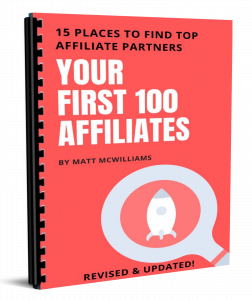 |
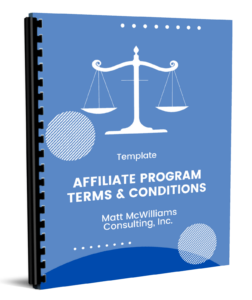 |
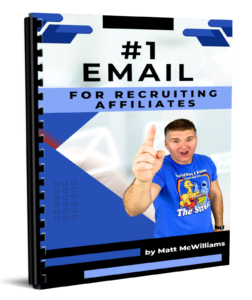 |
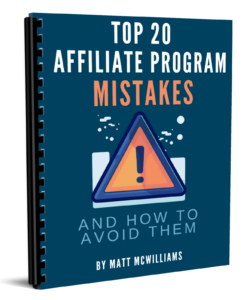 |
 |
 |
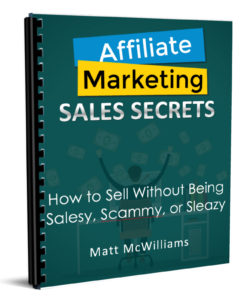 |
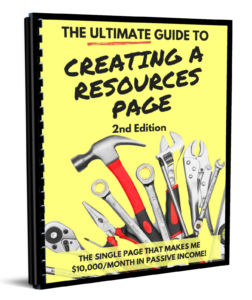 |
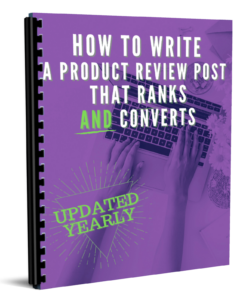 |


